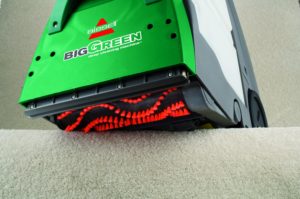
While there are a great many people with a great many opinions, we’re pretty sure it’s safe to say that almost no one likes carpet mold or mildew, with shady carpet cleaners being a possible exception. For the rest of us, it’s rather gross. Mold and mildew are hard enough to kill when they grow on tile, laminate, and other hard surfaces, but when they grow on carpets, mitigation and removal can be next to impossible. Beyond that, if you find carpet mold, you’ll typically find it in the carpet backing, and you often won’t find it there until it’s too late to save the carpet.
While most people think moldy carpets are exclusively caused by moisture, and that the way to get rid of mold is by getting rid of the moisture, the truth is a bit more complicated. Yes, you’ll want to control the moisture, but you’ll need to do a bit more than that. The good news is that once you figure out what to do–which we’ll go into in a moment–it’s fairly easy to keep carpet mold at bay. Read on for the scoop.
Why is mold a problem, and what does it have to do with basements?

You might have been warned when buying a home to never buy one with a carpeted basement, and to certainly avoid putting a carpet in a basement that didn’t already have one. These warnings are somewhat based in truth; while you can successfully install a carpet in a basement, the odds are against you for keeping it dry.
By definition, a basement is a hole in the ground, and due to groundwater, holes tend to be damp, if not outright wet places. This goes for all basements, including those that appear dry when smelling, touching, and looking at them. Even a small amount of humidity in a basement can lead to problems over time since there are few outlets through which moisture can escape.
Mold itself is unsightly, but it’s also a health risk, and that goes both for people with allergies and for people without them. Many molds create myoctoxins, which don’t affect the molds themselves but can seriously harm people, even those without any outstanding health concerns. And on a practical level, if you’ve got a mold-infested home, you’re going to have a fight on your hands when it’s time to sell it unless you pay for costly mitigation first.
But where does carpet mold actually come from?
However, as we hinted at above, there’s a catch: while moisture does contribute to mold growth on carpets (whether synthetic or natural), it’s not the only factor. Studies have been done on high humidity levels–the kinds of levels you’ll often find in rooms underground, such as in basement, or in other high-moisture locations, such as in bathrooms–in order to figure out just how much impact humidity had on mold growth.
Essentially, researchers compared clean, new, old, and dirty carpets across a range of humidity levels to look for mold growth. They defined high humidity levels as at least 80% humidity. Their results were surprising. Dirt was actually a larger contributor to mold growth than humidity in most cases. In other words, a slightly or heavily soiled carpet was more likely to create mold, and lots of it, than a clean carpet under a given moisture level.
Why does mold grow on dirty carpets and not on clean ones?
There are two main reasons why mold grows nearly exclusively on dirty carpets. The first is because mold spores naturally occur in dirt; the second is because dirt already has moisture built into it. As a result, the more dirt you allow on your carpets, the more likely they will be to develop mold. In contrast, clean carpets can tolerate very high levels of humidity and temperature without any mold growth whatsoever.
How do you keep mold and mildew from growing on carpets?
As suggested above, to keep mold and mildew at bay and away from your carpets, you don’t need to switch to hardwood floors. You just need to keep a few tips in mind:
1.) Clean your carpets and keep them clean. While researchers didn’t officially define what it meant to have a clean carpet, a good rule of thumb is to vacuum at least weekly with a high-quality, high-suction vacuum cleaner and seasonally with a good carpet cleaner. We’ll share our recommendations below. And the more frequently you vacuum and clean, the better.
2.) Lower your humidity levels. When it comes to mold prevention, the lower the ambient humidity, the better. We recommend keeping your home at 60% humidity levels or below if possible. Of course, you’ll need to balance this against the benefits of humidity for skin and respiratory comfort. If you can’t naturally lower humidity levels, a portable dehumidifier can work wonders.
3.) Lower your temperatures. Like humidity, temperature increases promote mold development. Mold prefers temperatures above 80 degrees Fahrenheit; take advantage of your HVAC system (air conditioning in particular) to lower your home temperatures and humidity levels at once.
4.) Use synthetic carpets. While we love nature, organic carpet fibers are more mold-friendly than synthetic, or inorganic fibers. In other words, stay away from wool and look for nylon, polyester, olefin, and triexta if possible.
Which carpet cleaners and vacuums are best for preventing mold growth?

As noted above, a clean carpet will be your best defense against mold infestations in your carpeting. This means frequent vacuuming and regular carpet cleaning. While you can get away with cheap machines in the short term, we recommend choosing cleaners that will be able to stand up to frequent use for decades without losing suction or giving you costly repair bills. In our books, that means a carpet cleaner like the Bissell 86T3 Big Green and a vacuum like the Miele Complete C3 Soft Carpet or the Miele Compact C2 Electro+. The Big Green is capable of cleaning efficiently and effectively without breaking the bank, and the Mieles are buy-it-for life machines capable of cleaning any bare floor or carpet style or pile.
![]() You can buy the Bissell 85T3 Big Green carpet cleaner here on Amazon. You can buy the Miele Complete C3 Soft Carpet here or buy the Miele Compact C2 Electro+ here.
You can buy the Bissell 85T3 Big Green carpet cleaner here on Amazon. You can buy the Miele Complete C3 Soft Carpet here or buy the Miele Compact C2 Electro+ here.
![]() Canadians can buy the Miele Soft Carpet here, the Compact Electro+ here, and the Bissell Big Green here.
Canadians can buy the Miele Soft Carpet here, the Compact Electro+ here, and the Bissell Big Green here.
 If you find our research on PMC helpful, you can follow our efforts to keep maniacally reviewing home cleaning tools by shopping through our links above. We promise to keep fighting the good fight against every horror children, animals, and grown, yet messy humans can inflict upon a clean home.
If you find our research on PMC helpful, you can follow our efforts to keep maniacally reviewing home cleaning tools by shopping through our links above. We promise to keep fighting the good fight against every horror children, animals, and grown, yet messy humans can inflict upon a clean home.

